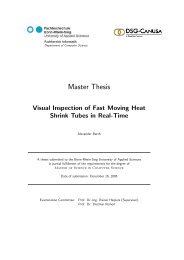Master Thesis - Hochschule Bonn-Rhein-Sieg
Master Thesis - Hochschule Bonn-Rhein-Sieg
Master Thesis - Hochschule Bonn-Rhein-Sieg
Create successful ePaper yourself
Turn your PDF publications into a flip-book with our unique Google optimized e-Paper software.
5. Algorithms <strong>Master</strong> <strong>Thesis</strong> Björn Ostermann page 81 of 126<br />
noise, the size of a region is counted while it is being filling (see chapter 5.2.4.1). If this size is below<br />
a certain threshold, the region is dropped from further processing. Figure 58 shows the objects of the<br />
sample workspace set-up that remain after size filtering.<br />
Figure 58: Remaining objects after region size filter<br />
Objects that only partially enter the camera’s view from the outside cause only small regions. For<br />
example this is the case, if only the hand of a human enters the visual field. If the number of pixels in<br />
those regions is smaller than the threshold, they are eliminated as well. Therefore the application of<br />
this filter is only possible in a workplace, where the camera’s view on the robot is larger than the<br />
robot’s possible reach (see Evaluation of safety in chapter 6.3).<br />
5.2.4.3 Distinguishing the robot from objects<br />
To distinguish the robot from other dynamic objects in the environment, the robot’s base was targeted<br />
manually in the intrusion map (see chapter 3.3).<br />
Every region that is extracted by the region growing algorithm (see chapter 5.2.4.1) is cross referenced<br />
with the base’s centre position. If this position is in the given region, the region is set as the robot’s<br />
region, as shown in Figure 59.<br />
Figure 59: Robot region identified by its base’s centre (blue cross)














